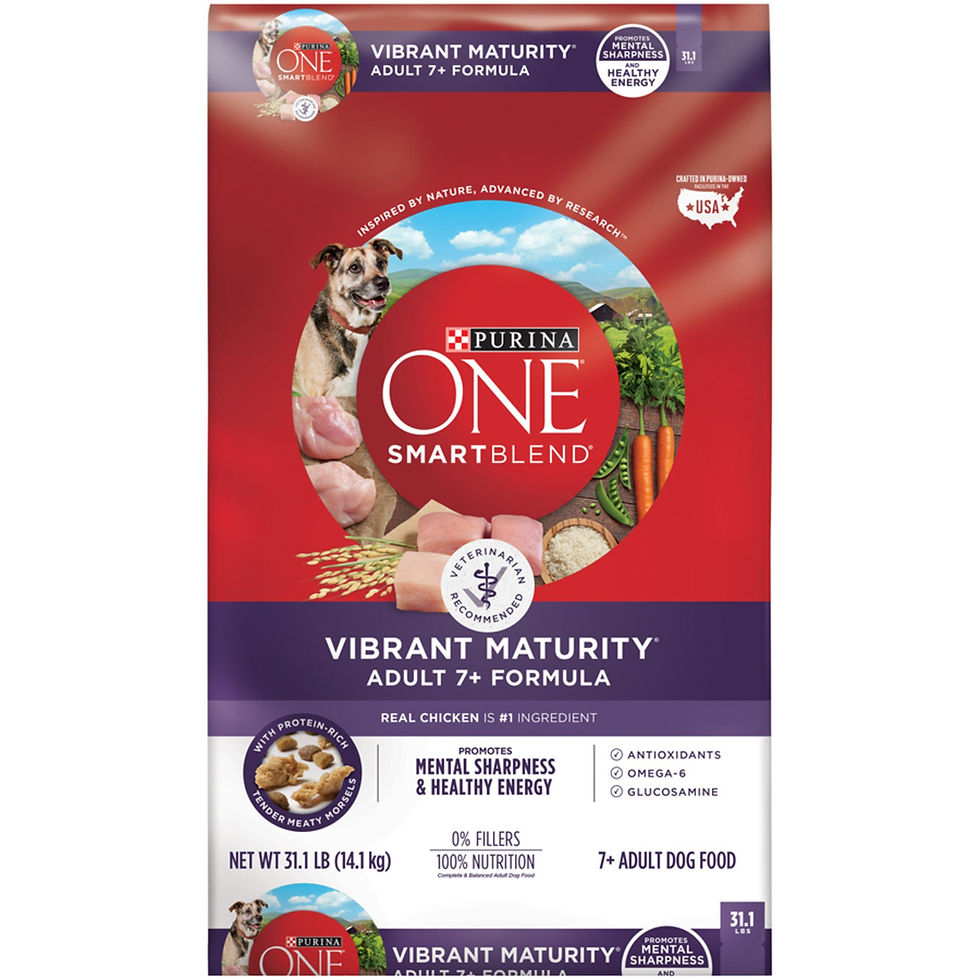COGNITIVE DYSFUNCTION: Dog & Cat Dementia
- tinypawssanctuary
- Nov 3, 2021
- 7 min read
Updated: Aug 26, 2022

Our pets are living longer because of the advancement in veterinary medicine and dedicated pet parents who are becoming more proactive in their pets' care. Vaccines have significantly reduced the number of deaths related to contagious viruses and spaying and neutering is preventing many diseases. Keeping our pets indoors has also helped in extending the lives of our dogs and cats.
Cats live on average of 10-14 years with more advanced ages becoming more common. In general, the smaller the dog, the longer the life expectancy. Giant breeds are seniors at 6-8 years old, while small breed dog are only in their mid-life at that age. Mixed breed dogs and cats live longer than purebred dogs and cats. Feral cats live about one half the lifespan of indoor cats because of diseases and illnesses spread by frequent fighting, lack of vaccines, food shortages, and traffic (hit-by-car). Dogs allowed to roam and unaltered dogs also tend to have a shorter lifespan. Click for more info on dog longevity

With this increase in life expectancy, we are more likely to see conditions and diseases associated with advanced age. One of those conditions that is frequently goes undiagnosed is Cognitive Dysfunction Syndrome (CDS). Cognitive dysfunction has sometimes been referred to by laymen as dementia, sundowners, kitty alzheimer's and doggie alzheimers.
Cognitive Dysfunction Syndrome is often considered a normal part of aging. It is not. CDS is a degenerative brain disease that is characterized, not only by cognitive changes, but actual physical changes in the brain. The brain mass itself may reduce, and the neurons that transmit messages from the brain to the body may reduce in number. Amyloid plaque, a toxic protein peptide, may begin to accumulate between the neurons, leading to death of even more neurons.
The destruction of neurons and the brain's ability to function properly results in changes in behavior. The once potty-trained dog may begin to urinate or defecate inside the home, and the cat may begin to void outside the litter box. The pet may become lost in familiar surroundings or stare at the wall. Pets with cognitive dysfunction may stand in the corner or press their heads against the wall. The dog may bark more, pace at night, or become more aloof. The cat may vocalize at night or become more needy. The pet's sleep schedule may change, and he may be unwilling to participate in his usual activities. She may become easily startled or may stop responding to her name.
A recent article published in the journal Scientific Reports, discusses the Dog Aging Project, a study involving 15,019 dogs. In the article, two top factors that may put the pet at risk of CDS were revealed. Researchers at the University of Washington found that animals who reported that their pets lived a more sedentary lifestyle compared to regularly exercised pets were 6.7 times more likely to develop the disease. Dogs with blindness or deafness were also at increased risk. It is believed that the lack of stimulation blind and deaf dogs received may be related.
Once an animal has been diagnosed with CDS, hope is not lost.

Several studies in humans, dogs, and cats have shown that a diet rich in antioxidants can help prevent and even diminish the signs of cognitive dysfunction.
Antioxidants counter the effects of free radicals, a natural by-product of metabolism. Free radicals produced in greater than normal amounts when pets (or people) are sick, elderly, exposed to toxins, or suffer from poor nutrition. A balance between free radicals and antioxidants is necessary for proper physiological function. If free radicals overwhelm the body's ability to regulate them, a condition known as oxidative stress ensues. Free radicals thus adversely alter lipids, proteins, and cause cellular damage. This damage can weaken the immune system and become a pathway to cancers and age-related diseases, among others.
Dog foods such as Hill's Prescription b/d are formulated precisely to provide these antioxidants. The food combines fatty acids, antioxidants (vitamins C and E, b-carotene, selenium, flavonoids, and carotenoids), as well as DL-a-lipoic diet and L-carnitine, which are intended to enhance mitochondrial function.

Its not only the antioxidants, however, that bring about positive results. One laboratory study, demonstrated that an enriched diet combined with an enriched environment provides the best results. In our pets, as in ourselves, maintaining an active mind even as we age appears to keep us all a little bit younger.
The promising effects of Hills Prescription b/d, while encouraging, are out of reach for many pet parents. The diet is sold at an average of $3.97 per lb, or $69.99 for a 17.6 lb bag.

Purina One Smartblend Vibrant Maturity dog and cat food are a more affordable option. The formula includes enhanced botanical oils containing medium-chain triglycerides (MCT) to provide ketone bodies as an alternate source of energy for aging neurons, dual defense antioxidant blend of Vitamins E & A along with minerals zinc and selenium. Vibrant Maturity Dog Food is available for about $37.43 $1.20 per lb in its 31.1 lb bag, while Vibrant Maturity Cat Food comes only in 7 lb bags at about $2.71 per lb. (A general rule of thumb: The larger the bag, the less the food will cost per lb).

Antioxidant supplements are available specifically for pets. Perhaps the most recommended by veterinarians is Cell Advance by Vetri Science. According to the Vetri Science website, the product provides "23 powerful antioxidants at levels designed to complement any protocol [and] includes vitamins A, C, E and B6 to support the immune system and protect against free radical damage. Antioxidants like alpha-lipoic acid offer protection from free radicals both inside and outside of the cell. Alpha lipoic acid might also extend the biochemical life of other important antioxidants like glutathione and A, C, and E. Coenzyme Q10 is a necessary co-factor for ATP production and immune system support. Cell Advance™ 880 also includes bioflavonoids like quercetin, rutin and hesperidin to support vascular and connective tissue health, maintain healthy collagen levels and protect cell structures from free radical damage." The advantage of buying a pet formulated formula is the ability to prevent an overdose of antioxidants which, in itself, can cause serious side effects.

Cell Advance 440 is formulated for dogs and cats and sells for about $13.80 for 60 capsules or 23 cents per capsule. The directions call for one capsule daily per 10 lbs. If giving more than one capsule per day, the manufacturer recommends giving half of the dose in the morning and the other half in the evening. Cell Advance 880 is available for larger dogs for $28.80 for 120 capsules or 24 cents per capsule. The directions advise to give 1 capsule per 20 lbs of body weight. Again, if more than one capsule is needed, divide the dose between morning and evening.
Melatonin has been shown to be effective in treating pets with cognitive dysfunction as well. Melatonin is particularly helpful for senior pets showing changes in their sleep cycle. It also appears to be helpful for pets with mild anxiety issues. Dosages for dogs range from 1.5-1mg for dogs under 25 lbs, 1-2 mg for pets 25-50 lbs, and 3 mg for pets over 50 lbs. It can be given up to 3 times daily. Cats can take 0.5-.75 mg twice daily (1/2-3/4 of a 1 mg tablet).

If using specifically to help regulate a proper sleep schedule, give the melatonin only at night. And never use gummies since they may contain a sweetener that is toxic to dogs. Softgels can be used for any dogs that take a 5mg dose.
The use of SAMe (S-Adenosyl-L-methionine) has been shown in a placebo-controlled study to improve the activity and awareness of dogs. Dosage is 100 mg for small dogs up to 22 lbs and all size cats, 200 mg for dogs 23-44 lbs, and 400mg for dogs over 45 lbs. It is available in an enteric coated tablet for better digestion under the name Novifit.

SAMe should not be given to a pet taking melatonin or any SSRI such as fluoxidine (trade name:Prozac).
Zykene was released by Vetoquinol in recent years. According to its website, Zylkene is the "only veterinary supplement formulated with alpha-cazosepine, a natural ingredient derived from bovine hydrolyzed milk protein that has clinically proven calming properties to help relax cats and dogs. It acts on inotropic GABA receptors and decreases stress reactions within 90 minutes."
The company does note that the more severe the anxiety, the longer it will take Zylkene to work. Although some pet parents use the supplement short term during stressful events, dogs and cats with consistent anxiety related (or not related) to cognitive dysfunction, can take it on a daily basis. We have found this product to be very effective at the sanctuary.

Although these products are available over-the-counter (with the exception of the prescription food, pet parents should consult with their veterinarian before starting their pets on any type of supplement. Some supplements may interfere with prescription drugs.
When these over the counter supplements are no longer effective by themselves, there are prescription medications to help. Selegiline hydrochloride (trade name: Anipryl) is one of the most common prescription treatments for cognitive dysfunction. The drug was originally developed for treatment of Alzheimer's and Parkinson's in humans and improves the function of the messenger receptors in the brain.
Over the years, we have become very familiar with canine cognitive dysfunction. Ruby and Bear, both chihuahua mixes and Laygo, an American Eskimo mix all suffered from the disease. Ruby and Bear presented with extreme anxiety, shaking, and hiding. Laygo, who was also blind and mostly deaf, would become more and more agitated as the evening wore on. He would press his head against the wall, a classic sign. It was only when we tried every possible treatment for their illnesses, did we have to consider euthanasia.
Ruby, was particularly difficult for me. She was my emotional support dog and, if one looked at her, they would believe that she was physically healthy. Her brain was not. She lived in fear every day. Although I received a lot of negative feedback for my decision to euthanize her, I refused to let her live in fear. One thing that event taught me...always be your pet's biggest advocate and listen to your gut. Ruby was ready, and I knew it. I loved her enough that I let her go.
Proactive pet parenting is all about close observation of one's pet. In practicing the discipline, we can catch symptoms early and give our pet's the best quality of life possible.




Comments